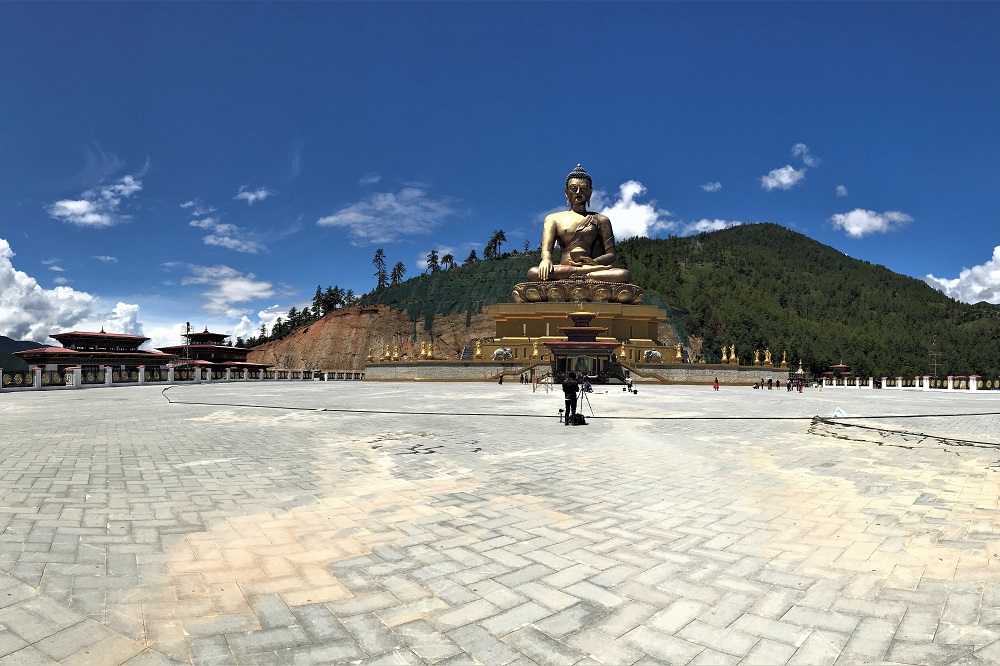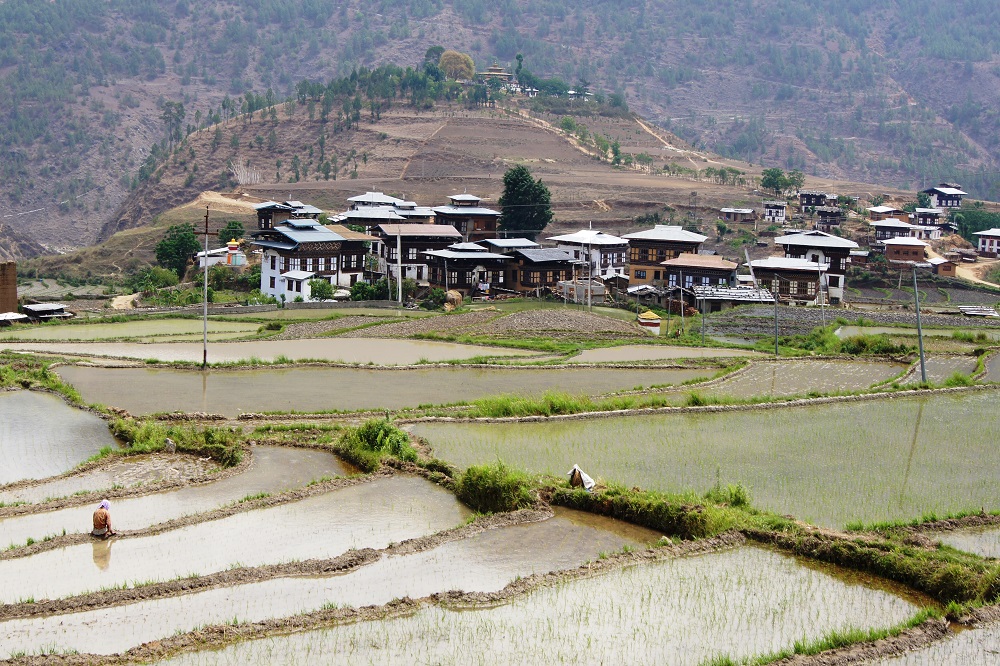Bhutan - The Happiness Kingdom Tour
Culture, Nature and Historical excursion of the Land of Happiness – Bhutan!
Duration: 10 Nights 11 Days
Places visited: Thimphu, Gangtey (Phobjikha), Punakha, Wangduephodrang, Dochu La, Haa Valley across Chele La & Paro including hike to Tiger’s Nest.
Best Seasons to Visit: March to May & September to early December
Moderate Seasons to Visit: January, February, June, July, August & Late December
Trip Grade: Easy to fairly moderate
Tour Type/Group Size: Private tour of you and your friends and families only.
Special Notes: Itinerary can be fine-tuned depending on your interests.
Day 1: Arrive Paro (Bhutan) by Flight & transfer to Thimphu (55km, approx. 1.1/2-hour drive)
The flight to Paro is one of the most spectacular in entire Himalayas. Flying along the Himalayan range from Kathmandu or over Himalayan foothills if flying from Kolkatta, the journey offers fascinating views and an exciting descent into the Kingdom. Bhutan’s first gift to you as you disembark from the aircraft will be cool, clean fresh mountain air.
After immigration formalities and baggage collection you will be welcomed by our representative and embark on a picturesque drive to Thimphu, the capital town of Bhutan. The road leads through the Paro valley to the confluence of Paro and Thimphu rivers at Chuzom (confluence).
Shortly before reaching Chuzom, you will see on your left Tamchog Lhakhang, the temple built by Thangtong Gyalpo, a pioneering engineer who introduced the construction of suspension bridges into Bhutan and Tibet (several of which are still in use today). The present bridge to Tamchog Lhakhang was restored in 2005 in the design of a traditional style with iron chains and crossing this iron bridge is a wonderful experience.
On arrival, in Thimphu check-into the hotel. The capital town of Bhutan and the centre of government, religion and commerce, Thimphu is a unique city with unusual mixture of modern development alongside ancient traditions. It is perhaps still the world’s only capital city without a traffic light.
Later in afternoon walk around National Memorial Chorten, a large white structure crowned with a golden spire. It is located close to the center of Thimphu city and is one of its most iconic monuments. This is the most ideal spot to interact with locals who throng in large numbers to circumambulate the chorten, whirl the large red prayer wheels and pray at a small shrine inside the gate. The paintings and statues inside the monument provide a deep insight into Buddhist philosophy.
Afterwards an exploratory walk around Thimphu main street and market area.
Overnight at the hotel in Thimphu (Altitude 2,320m).
Day 2: Thimphu
Morning after breakfast, drive to see the iconic gigantic Buddha Dordenma (Vajra seated), the world’s largest sitting bronze statue. Majestically situated at Kuenselphodrang, it is an object of great veneration to all sentient beings. The land at Kuenselphodrang measuring 145 acres was gifted to Monks Body by His Majesty the Fourth King of Bhutan. The Park conserves 798.4 acres of forest area that surrounds the Buddha Dordenma statue. Dedicating it to the 60th birth anniversary celebration of His Majesty the Fourth Druk Gyalpo, His Holiness the Je Khenpo consecrated the 201 feet tall Buddha Dordenma statue at the Kuenselphodrang on 24th September 2015.
After this insightful visit drive to Textile Museum, established in 2001 under the royal patronage of Her Majesty Gyalyum Sangay Choden Wangchuck. The museum is managed by the Department of Culture, Ministry of Home & Cultural Affairs, Royal Government of Bhutan. Exhibitions here introduce the major weaving techniques, styles of local dress and textiles made by women and men.
Institute for Zorig Chusum, commonly known as Arts & Crafts School or Painting School is an important learning center that offers a six-year course on the 13 traditional arts and crafts of Bhutan. On a visit, one can see students learning the various skills taught at the school.
Located below the main town, Centenary Farmers Market popularly known as Weekend market is a pleasant, colourful & delightful place to mingle with locals. Farmers come from all over the country to sell their farm products in this market. Also available here are the handicrafts and artifacts, to purchase.
Then visit Changangkha Lhakhang, one of the ancient temples in Thimphu established on a site chosen by Phajo Drukgom Shigpo, the founder of Drukpa lineage in Bhutan. The central statue here is Chenrezig in a manifestation with 11 heads. From temple courtyard, there is fascinating view of Thimphu valley.
Conclude the sightseeing of the day with visit of Trashichhoedzong that has been the seat of the government since 1952 and presently houses the throne room and offices of His Majesty the King, the Secretariat and the Ministries of Home affairs and Finance. The dzong is located close to Thimphu town, next to the banks of the Wang Chhu River. It is an impressively large structure, surrounded by well-kept lawns and beautiful gardens.
Evening free to explore the government-run Handicrafts Emporium and local crafts Bazaar, to browse through example of Bhutan's fine traditional arts constituting hand-woven textiles, thangkha paintings, masks, ceramics, slate and wood carvings, jewellery, interesting items made from local materials.
Overnight at the hotel in Thimphu (Altitude 2,320m).
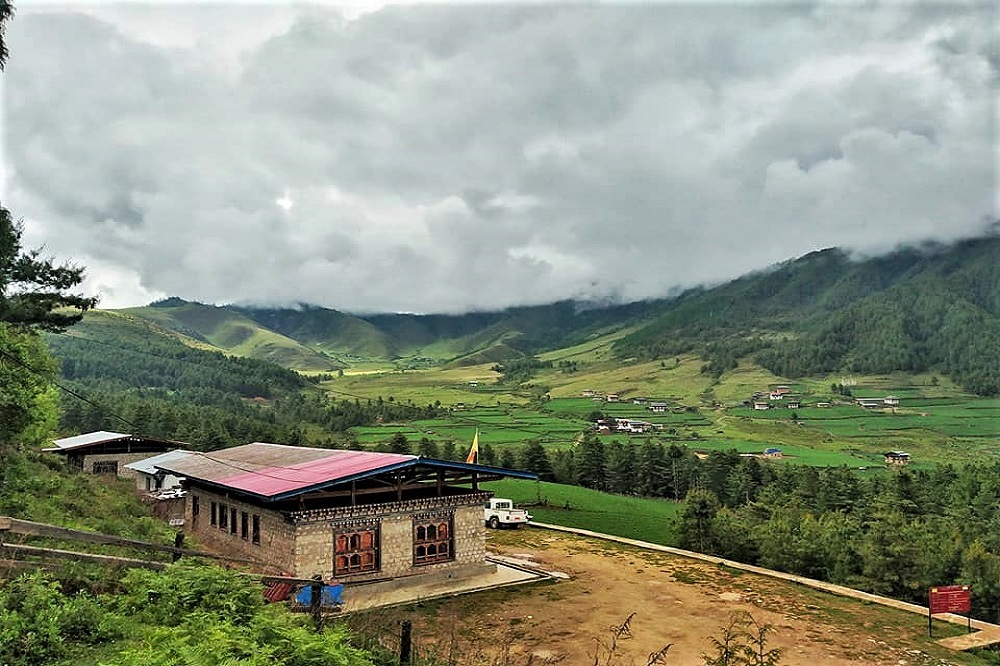
Day 3: Thimphu – Gangtey (150km, approx. 5-hour drive)
After breakfast drive up to Dochu-la pass (3,088m/ 10,130 ft) stopping briefly here to take in the view and admire the chorten, mani wall, and prayer flags which decorate the highest point on the road. If skies are clear, the following peaks can be seen from this pass (left to right): Masagang (7,158m), Tsendagang (6,960m), Terigang (7,060m), Jejegangphugang (7,158 m), Kangphugang (7,170 m), Zongphugang (7, 060 m), a table mountain that dominates the isolated region of Lunana - finally Gangkar puensum, the highest peak in Bhutan at 7,570m.
At Dochula Pass, 108 chortens or stupas known as Druk Wangyal Chortens have been built by Ashi Dorji Wangmo Wangchuk, the eldest Queen Mother. These chortens are built in three layers, the first lowest level layer has forty-five chortens, the second has thirty-six and the top layer has twenty-seven, built around the main chorten.
Then drive onto Gangtey. The valley of Gangtey is one of the most beautiful and unspoiled places in Bhutan. The surprise of finding such a wide, flat valley without any trees after the hard climb through dense forests is augmented by an impression of vast space and is an extremely rare experience in Bhutan where most of the valleys are tightly enclosed. A few kilometers beyond the Gangtey Monastery, on the valley floor lies the village of Phobjikha.
On arrival, check into the hotel.
Evening visit a traditional farmhouse. Picturesque farmhouses dot the valley amongst fields and hillsides. Bhutanese farmhouses are very colorful, decorative and traditionally built without the use of single nail. All houses follow the same architectural pattern.
Overnight at the hotel in Gangtey (Altitude 3,000m).
Day 4: Gangtey
Morning visit Gangtey Goempa. Perched on a small hill that rises from the valley floor, the Gangtey Monastery is the only Nyingmapa monastery on the western side of the Black Mountain’s and also the biggest Nyingmapa monastery in Bhutan. The Monastery is home of Gangtey Tulku, a highly respected reincarnate lama and its complex also includes a school, meditation facilities and residential quarters for monks. A charming, quaint village surround the monastery which is mainly inhabited by the families of the 140 Gomchens who take care of the Monastery.
Afterwards embark on a walking excursion to Gangtey Nature Trail. This pleasurable walk will give you a nice feel of Phobjikha valley. From the small hilltop overlooking Gangtey Goemba, you head downhill through flower meadows to Semchubara village and from here through beautiful forests and into the open valley. The trail ends at local community school after passing a chorten and Khewa Lhakhang. (approx. 5.5km, 2 hours walk).
Post lunch, explore fascinating Phobjikha valley. This place is the winter home of black necked cranes that migrate from the arid plains in the north to pass winter in milder and lower climate. The valley boasts two beautiful meandering rivers, Nakay Chhu (Chhu Naap-black water) and Gay Chhu (Chhu Karp-white water).
Also visit Black Neck Crane Information Centre. Situated on the edge of the forest and wetland along the main road of Phobjikha valley, the black-necked crane information Centre has an observation room equipped with high power telescope and spotting scopes for catching the best view of the cranes. The centre also offers display information that outline the natural and cultural history of the area. There is a small gift shop, which sells handicrafts produced by the local people.
Overnight at the hotel in Gangtey (Altitude 3,000m).
Day 5: Gangtey – Punakha (85km, approx. 3-hour drive)
After leisurely breakfast, drive onward to Punakha.
Punakha served as the capital of Bhutan and seat of government until 1955 and still it is the winter seat of Je Khenpo (the chief abbot). Blessed with temperate climate and owing to its natural drainage from Pho Chhu (male) and Mo Chhu (female) rivers, the fertile Punakha valley produces abundant crops and fruits. Located at an elevation of 1300m above sea level, Punakha enjoys mild winters and is popular year-round destination.
After lunch, visit Punakha Dzong. Also known as ‘The Palace of Great Bliss’, Punakha Dzong was built strategically at the junction of Pho Chhu and Mo Chhu rivers in 1637 by Zhabdrung Ngawang Namgyal to serve as the religious and administrative centre of the region. The Dzong has played an important role in Bhutan’s history and on 17 December 1907, the first King of Bhutan Gongsar Ugyen Wangchuk, was crowned here. Damaged by six catastrophic fires, an earthquake and once by flood, the Dzong has been fully restored by the fourth King. Dzongchung (or the little Dzong), built in 1328 by saint Ngagi Rinchen can still be seen opposite the main Dzong.
Then embark on a short walking excursion to Chimi Lhakhang:
The Chimi Lhakhang (temple), situated on a round hillock in the centre of Punakha valley near Lobesa, was built in 1499 by the 14th Drukpa hierarch, Ngawang Choegyel, after the site was blessed by the maverick saint Drukpa Kuenley who in the late 15th century used humour, songs and outrageous behaviour to dramatise his teachings and owing to this also known as ‘Divine Madman’. The Lhakhang is situated about 10 km from centre of Punakha town near Sopsokha village, from where a 20-minute walk through fields of mustards and rice, leads to a hillock that is the site of temple. Prayer flags are lined all along the road from the tiny village hamlet known as Yowakha, along a stream to the monastery. All houses in the village are decorated with paintings of phalluses on their exterior walls. The lama Kuenley had called the hillock where the monastery exists as the breast of a woman because of its round shape.
Overnight at the hotel in Punakha. (Altitude 1,300m)
Day 6: Punakha
After breakfast, a beautiful hike takes one to the regal Khamsum Yuelley Namgel Chorten, which was built to remove negative forces and promote peace, stability and harmony in the changing world. The Chorten dominates the upper Punakha Valley with commanding views across the Mo Chhu and up towards the mountainous peaks of Gasa and beyond.
Post lunch, excursion to Talo village, which is scattered along the hill slopes and known for its cleanliness and hygiene among Punakha villages. Visit Talo Sangnacholing Dzong, built on a plateau and offers majestic view of surrounding villages. The beautiful farmhouses of the village have its own flower gardens and on the hill slope corns and sweet peas are grown in abundance. Spend time at Nobgang and Talo villages visiting farmhouses and meeting families, experiencing Bhutanese rural life.
Later while returning to Punakha, on the way visit Nalanda Buddhist Institute. Locals call this place ‘Dalayna’ and the monks call it Nalanda Buddhist College. The Nalanda Buddhist Institute is a monastic school near the village of Talo, above the Punatsangchu river. Here you’ve opportunity to interact with monks, for knowledge on Buddhism, process of meditation.
Evening explore Wangdue town and market area.
Overnight at the hotel in Punakha. (Altitude 1,300m)
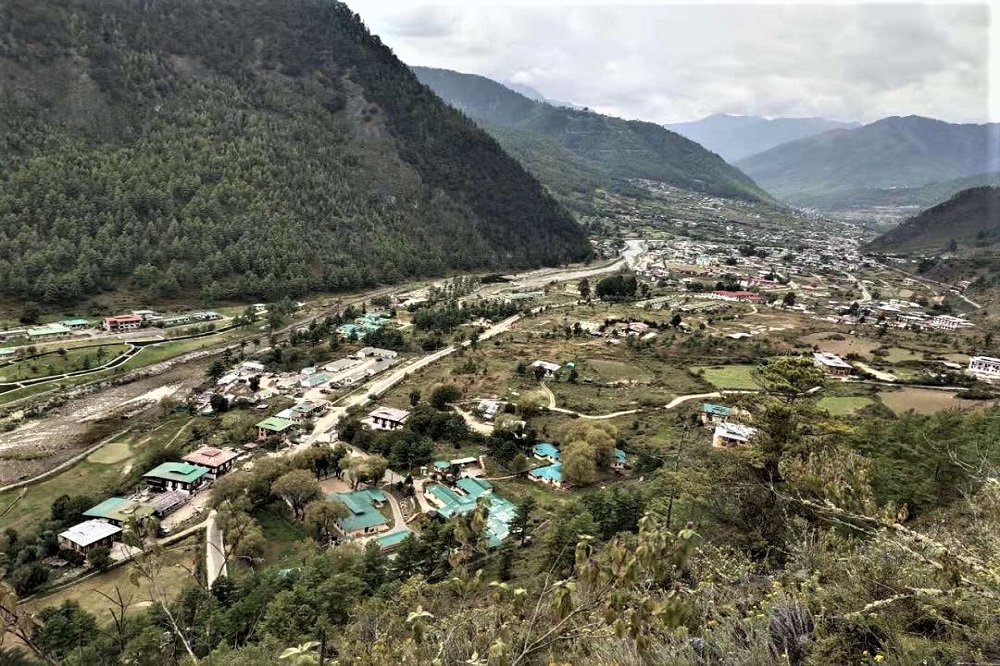
Day 7: Punakha – Haa Valley (175km, approx. 6-hour drive)
After breakfast, proceed to Haa valley. Blessed with incredible natural beauty, Haa valley is the smallest district in the country and also the second least populated district in the country. It is one of the most exotic valleys in the country, opened for foreign tourists only in 2002.
On the way, visit Simtokha Dzong, one of the oldest fortresses of the country, built in 1629. Legend associated with dzong’s construction mention that the fortress was built to subdue a demon that was harassing travellers to this region. The most noteworthy artistic feature of this dzong is the series of over 300 finely worked slate carvings behind the prayer wheels in the courtyard.
Progressing further take a short photo stop at Chuzom, the confluence of Paro & Thimphu rivers.
On arrival in late afternoon check into the hotel. Evening take a stroll in majestic Haa valley, a steep north-south valley with a narrow floor. Also known as ‘Hidden-Land Rice Valley’, it is one of the most beautiful and isolated areas in Bhutan, adorned with pristine alpine forests and majestic mountain peaks. Alongside Buddhist practices, the people of Haa practice shamanistic traditions also. The most significant of the shamanistic traditions is the annual ceremony to honour the guardian deity of the valley – Ap Chhundu. The people of Haa also celebrate their new year – known as Lomba – much earlier than people in other parts of country. Haa is also home to a number of nomadic herders and hosts an annual ‘Haa summer festival’ which is a lively celebration of the mix of traditional living-culture, nomadic lifestyles, unique Bhutanese cuisines, traditional sports and religious performances. It provides insight into the lives and traditions of Bhutan’s nomadic herders.
Overnight at the hotel in Haa valley (Altitude 2,670m)
Day 8: Haa Valley
Morning after breakfast, proceed on approx. 4-hour walking trip from Lechuna Village to Jamte Goenpa. Begin your walk through the lower village of Lechuna and continue on down to the Haa Chhu (river) before crossing a quaint wooden bridge. From here the walk to Jamte goenpa is gradual ascent taking about 1.5 hour through pristine forest which later opens up to the village. Visit the monastery which is more than 300 years old followed by visit to a village house. The view of southern Haa valley can be enjoyed best from here. Then we take a seldom used animal track that connects on to the main trail after an hour’s walk. Continue onto Chumpa bridge to stop for picnic lunch beside the river. After lunch, we walk slowly through the beautiful Chuma village taking time to see the villagers at work and even have some interaction with them. Walking along the village path, we reach to motorable road and drive on to our lodge.
Afternoon visit famous temple of Lhakhang Karpo. Also known as ‘White temple’, Lhakhang Karpo was established in 7th century by Tibetan King Songtsen Gempo in his mission to built 108 monasteries in one day. According to legend, a white and black pigeon were released to select the site for temples and the white pigeon landed on the foothills of the three towering mountains worshipped as Rigsum Gonpo and is where Lhakhang Karpo stands today.
Then visit Lhakhang Nagpo. Situated towards north of Lhakhang Karpo and located in Dumchoe village, Lhakhang Nagpo also known as Black temple was established in the 7th century by Tibetan King songtsen Gampo. Lhakhang Nagao & Lhakhang Karpo stands as guardian sentinels keeping watch at the south entrance of the valley.
Evening at leisure in Haa town.
Overnight at the hotel in Haa valley (Altitude 2,670m)
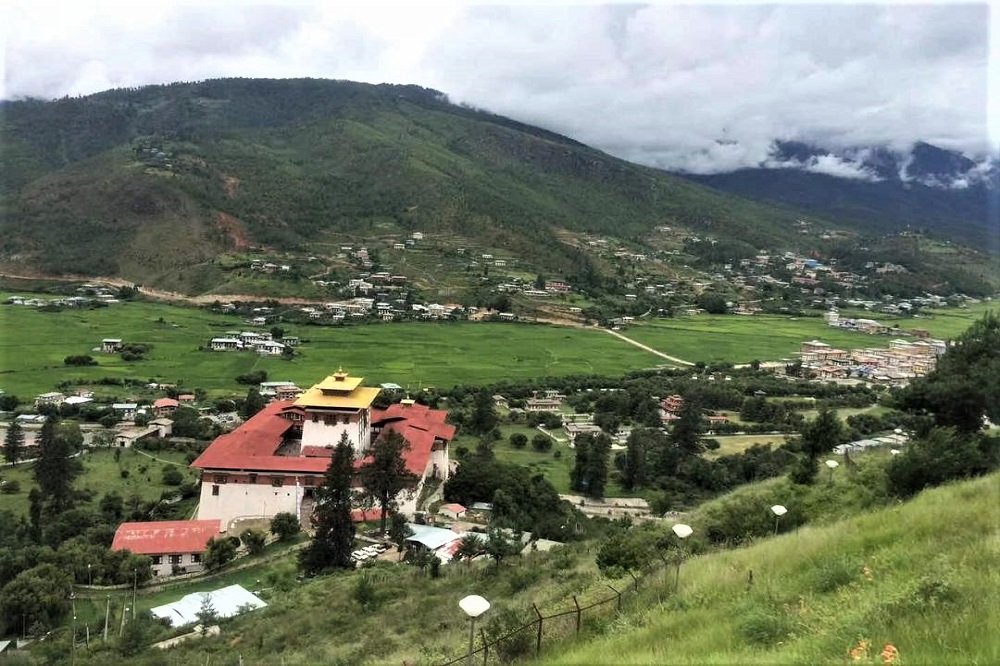
Day 9: Haa valley - Paro (70km, approx. 3-hour drive)
After breakfast, drive to Paro en route taking a short stop at Chelela pass. Located at an elevation of 3,988 meters, Chelela is considered to be one of the highest motorable passes in Bhutan. About an hour's drive along a thickly forested road, this Pass is a botanical paradise, providing stunning views of the sacred mountain Jomolhari and Jichu Drake. It is also marked by hundreds of prayer flags fluttering in the wind.
From Chelela, embark on a fascinating excursion to Kila Gompa, a nunnery perched on a steep cliff face at 3500m. This staggering site manages to house 7 small temples and about 70 nuns. From Chelela pass, the Gompa is about an hour walk amidst magnificent, wooded area.
On arrival in Paro, check into the hotel.
Afternoon visit Ta Dzong, originally built as Watchtower, which now houses National Museum. This seven-storied watch tower fortress or Ta Dzong was built in 1649 and during 1968 converted into National Museum of the country. The extensive collection includes antique thangkha paintings, textiles, weapons & armour, household objects and a rich assortment of natural and historic artifacts.
After the visit, walk down the trail to explore 17th century Rinpung Dzong, meaning (‘Fortress of the heap of jewels’), which has a long and fascinating history. The Dzong ranks as a high point of Bhutanese architecture. Its massive, buttressed walls that tower over the town are visible through the valley. Inside Rinpung Dzong are 14 shrines and chapels including Sandalwood Stupa, Protector’s shrine, Temple of the Guru’s eight manifestations, Chapel of the head lama, Chapel of the eleven-faced Avalokiteshvara, Temple of the Treasure Revealer, Temple of the Bursar.
Overnight at the hotel in Paro (Altitude 2,280m).
Day 10: Paro
After breakfast, the morning is reserved to visit Taktsang Monastery (approx. 5-hour round trip walk), one of the fabulous locations in the known world. The Taktsang Monastery is the most famous of Bhutan’s monasteries, perched on the side of a cliff 900m above the Paro valley floor. It is said that Guru Rinpoche arrived here on the back of a tigress and meditated at this monastery and hence it is called ‘Tiger’s Nest’. This site has been recognized as a most sacred place and visited by Zhabdrung Ngawang Namgyal in 1646 and now visited by all Bhutanese at least once in their lifetime. On 19 April 1998, a massive fire had severely damaged the main structure of building but later this Bhutanese jewel got restored to its original splendour.
Afternoon drive to the base of Drukgyel Dzong, a ruined fortress where Bhutanese warriors fought Tibetan invaders centuries ago. The snowy dome of sacred Chomolhari, ‘mountain of goddess' can be seen in all her glory from the approach road to the Dzong. Nearby visit a traditional farmhouse, which offers deep insight into lifestyle of village folks.
While returning to the hotel, en route visit the 7th century Kyichu Lhakhang, one of the 108 temples built in the Himalayas by Tibetan King, Songtsen Gampo. The building of this temple marks the introduction of Buddhism in Bhutan.
Overnight at the hotel in Paro. (Altitude 2,280m)
Day 11: Depart Paro
After breakfast, transfer to the airport for flight to onward destination. Our representative will help you with exit formalities and bid you farewell.
HOTELS IN THIMPHU
HOTELS IN PUNAKHA & WANGDUE
HOTELS IN GANGTEY
HOTELS IN TRONGSA
HOTELS IN BUMTHANG
HOTELS IN MONGAR
HOTELS IN TRASHIGANG
HOTELS IN SAMDRUP JONGKHAR
HOTELS IN PHUENTSHOLING
HOTELS IN HAA
HOTELS IN GELEPHU
HOTELS IN ZHEMGANG
RESTAURANTS IN PARO
RESTAURANTS IN THIMPHU
RESTAURANTS IN PUNAKHA
TOUR ITINERARIES
TREKKING ITINERARIES
SPECIAL INTERESTS TOURS
UNIQUE FESTIVALS & FAIRS
BLOG
